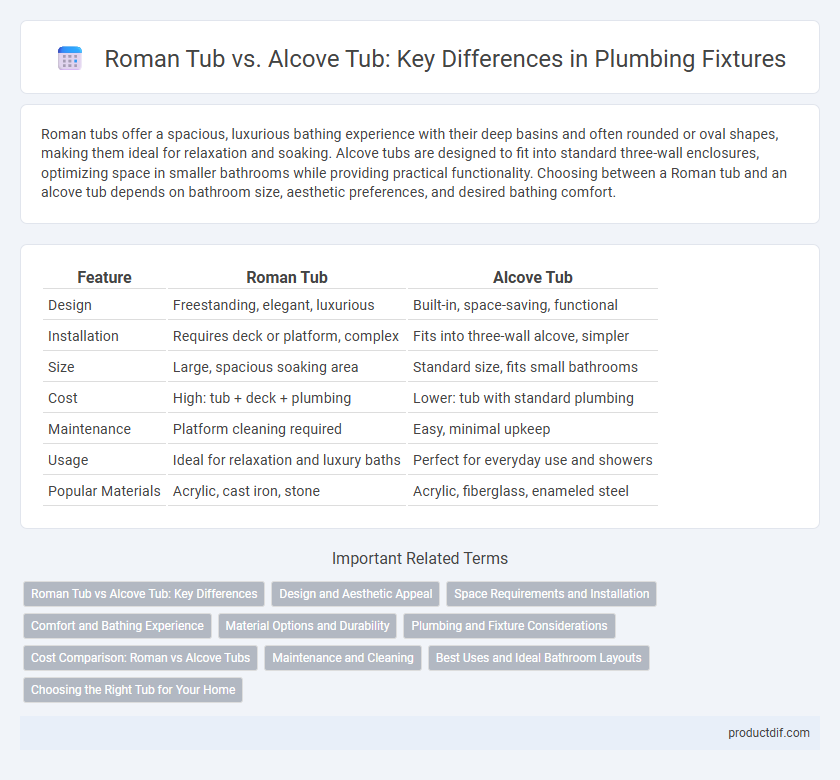Roman tubs offer a spacious, luxurious bathing experience with their deep basins and often rounded or oval shapes, making them ideal for relaxation and soaking. Alcove tubs are designed to fit into standard three-wall enclosures, optimizing space in smaller bathrooms while providing practical functionality. Choosing between a Roman tub and an alcove tub depends on bathroom size, aesthetic preferences, and desired bathing comfort.
Table of Comparison
| Feature | Roman Tub | Alcove Tub |
|---|---|---|
| Design | Freestanding, elegant, luxurious | Built-in, space-saving, functional |
| Installation | Requires deck or platform, complex | Fits into three-wall alcove, simpler |
| Size | Large, spacious soaking area | Standard size, fits small bathrooms |
| Cost | High: tub + deck + plumbing | Lower: tub with standard plumbing |
| Maintenance | Platform cleaning required | Easy, minimal upkeep |
| Usage | Ideal for relaxation and luxury baths | Perfect for everyday use and showers |
| Popular Materials | Acrylic, cast iron, stone | Acrylic, fiberglass, enameled steel |
Roman Tub vs Alcove Tub: Key Differences
Roman tubs typically feature a freestanding, deep design with a wider rim, ideal for luxurious soaking and often installed in spacious bathrooms. Alcove tubs are enclosed on three sides, maximizing space efficiency and commonly integrated with shower surrounds in smaller or more practical bathroom layouts. The key difference lies in their installation style and space utilization, with Roman tubs emphasizing elegance and comfort, while alcove tubs prioritize functionality and compactness.
Design and Aesthetic Appeal
Roman tubs feature a sleek, drop-in design that integrates seamlessly into bathroom architecture, offering a luxurious and elegant aesthetic with their deep, rectangular shape. Alcove tubs are three-sided fixtures enclosed on three walls, providing a traditional and space-efficient solution often complemented by shower surrounds or tiles for a clean, classic look. The choice between these plumbing fixtures hinges on preferred style: Roman tubs emphasize sophistication and soaking comfort, while alcove tubs prioritize practicality and a timeless bathroom design.
Space Requirements and Installation
Roman tubs require significantly more space and often need a dedicated platform or deck for installation, making them ideal for larger bathrooms. Alcove tubs are designed to fit into a three-wall enclosure, optimizing space in smaller bathrooms and simplifying the installation process. The alcove tub's compact design and built-in walls reduce the need for additional framing or decking compared to the bulky and open design of Roman tubs.
Comfort and Bathing Experience
Roman tubs offer a spacious, deep soaking experience with ergonomic seating that enhances relaxation, making them ideal for comfort-focused bathing. Alcove tubs, designed for efficient use in smaller spaces, provide a practical and versatile bathing option, often combined with shower functionality. The choice between the two impacts the overall bathing experience, with Roman tubs prioritizing luxury and Alcove tubs emphasizing convenience.
Material Options and Durability
Roman tubs often feature solid surface materials like cast stone or cultured marble, providing a durable and heavy structure that resists chipping and cracking. Alcove tubs are commonly made from acrylic or fiberglass, offering lightweight options that are less prone to staining but may be more susceptible to scratching. Durability varies with material choice, where Roman tub materials typically deliver superior longevity compared to standard alcove tub composites.
Plumbing and Fixture Considerations
Roman tubs require dedicated plumbing lines for separate filler spouts and often include deck-mounted or freestanding fixtures, demanding robust water pressure and precise valve placements. Alcove tubs typically integrate with existing three-wall enclosures, utilizing standard wall-mounted shower valves and spouts, simplifying installation and maintenance. Plumbing must accommodate the fixture type to ensure optimal water flow, proper drainage, and compliance with local codes.
Cost Comparison: Roman vs Alcove Tubs
Roman tubs generally have a higher price point due to their larger size, custom installation requirements, and luxury design, often ranging from $2,500 to $7,000 or more. Alcove tubs, designed for space efficiency and standard installations, typically cost between $400 and $1,500, making them a budget-friendly option for many homeowners. Installation costs for Roman tubs can also be significantly higher because of potential structural modifications and specialized plumbing needs.
Maintenance and Cleaning
Roman tubs feature wide, flat edges that simplify wiping down surfaces and prevent buildup of soap scum, while alcove tubs often have tight corners that trap dirt and require more detailed scrubbing. The materials of Roman tubs, often high-quality porcelain or stone composites, resist staining and discoloration better than standard acrylic or fiberglass used in many alcove tubs. Routine maintenance for Roman tubs includes cleaning broad flat surfaces and ensuring the surrounding deck remains dry, whereas alcove tubs demand frequent attention to grout lines and caulk to prevent mold and mildew growth.
Best Uses and Ideal Bathroom Layouts
Roman tubs, characterized by their deep soaking design and deck-mounted fixtures, are best suited for spacious bathrooms where a luxurious centerpiece is desired, often installed against a wall with ample surrounding space. Alcove tubs fit efficiently within three-walled enclosures, making them ideal for compact, functional bathrooms that require integrated shower-tub combos without sacrificing space. The choice between Roman and alcove tubs hinges on bathroom size and layout priorities, with Roman tubs enhancing aesthetic appeal in larger layouts and alcove tubs optimizing utility in smaller or multi-use spaces.
Choosing the Right Tub for Your Home
Choosing the right tub for your home depends on space, style, and functionality requirements. Roman tubs offer a luxurious, open design ideal for spacious bathrooms and deep soaking experiences, while alcove tubs fit three-walled enclosures, saving space and often featuring built-in shower curtains or doors. Consider bathroom size, plumbing layout, and personal bathing preferences to determine whether a roman tub or alcove tub best suits your lifestyle and home design.
roman tub vs alcove tub Infographic

 productdif.com
productdif.com